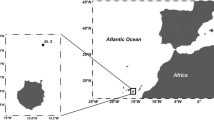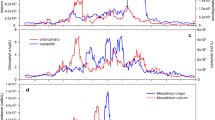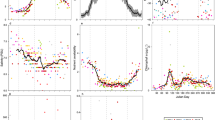Abstract
Bacteria are relevant members of planktonic food webs, both in terms of biomass and production share. The assessment and comprehension of the factors that control bacterial abundance and production are, thus, necessary to understand how carbon and nutrients circulate in planktonic food webs. It is commonly believed that bacterial abundance, activity and production are either determined by the available nutrient levels (‘bottom-up’ control) or by the effect of predators (‘top-down’). These factors have also been shown to regulate the internal structure (the physiological and phylogenetic structure) of the bacterioplankton black box. We present here different empirical and experimental ways in which the factors that control bacterial communities are assessed, among them, the direct comparison of the rates of bacterial growth and losses to grazing. Application of several of these methods to open ocean data suggests that bacteria are regulated by resources at the largest scales of analysis, but that this overall regulation is strongly modulated by predators in all types of systems. In the most oligotrophic environments, bacterial abundance and growth are regulated by predators, while in the richest environments it is bacterial (phylogenetic, size, activity) community composition that is most affected by protist predators, while abundance can be influenced by metazoans. Because changes in bacterial community composition require that bacteria have enough nutrient supply, the overall effect of these regulations is that bacterial growth appears to be top-down regulated in the most nutrient-poor environments and bottom-up regulated in the richer ones.
Similar content being viewed by others
References
Andersen P & Fenchel T (1985) Bacterivory by microheterotrophic flagellates in seawater samples. Limnol. Oceanogr. 30: 198–202
Azam F, Fenchel T, Field JG, Gray JS, Meyer-Reil LA & Thingstad F (1983) The ecological role of water-column microbes in the sea. Mar. Ecol. Prog. Ser. 10: 257–263
Bedo AW, Acuña JL, Robins D & Harris, RP (1993) Grazing in the micron and submicron particle size range: The case of Oikopleura dioica (appendicularia). Bull. Mar. Sci. 53: 2–14
Berninger U-G, Finlay B & Kuuppo-Leinikki P (1991) Protozoan control of bacterial abundances in freshwater. Limnol. Oceanogr. 36: 139–147
Biddanda B, Ogdahl M & Cotner J (2001) Dominance of bacterial metabolism in oligotrophic relative to eutrophic waters. Limnol. Oceanogr. 46: 730–739
Billen G, Servais P & Becquevort S (1990) Dynamics of bacterioplankton in oligotrophic and eutrophic aquatic environments: bottom-up or top-down control? Hydrobiologia 207: 37–42
Calbet A, Landry MR & Nunnery S (2001) Bacteria-flagellate interactions in the microbial food web of the oligotrophic subtropical North Pacific. Aquat. Microb. Ecol. 23: 283–292
Carlson CA, Ducklow HW & Sleeter TD (1996) Stocks and dynamics of bacterioplankton in the northwestern Sargasso Sea. Deep-Sea Res. 43: 491–515
Caron DA, Peele ER, Lim EL & Dennet MR (1999) Picoplankton and nanoplankton and their trophic coupling in surface waters of the Sargasso Sea south of Bermuda. Limnol. Oceanogr. 44: 259–272
Cochlan, WP (2001) The heterotrophic bacterial response during a mesoscale iron enrichment experiment (IronEx II) in the eastern equatorial Pacific Ocean. Limnol. Oceanogr. 46: 428–435
Coffin RB & Sharp JH (1987) Microbial trophodynamics in the Delaware Estuary. Mar. Ecol. Prog. Ser. 41: 253–266
Cole JJ, Findlay S & Pace ML (1988) Bacterial production in fresh and saltwater ecosystems: a cross-system overview. Mar. Ecol. Prog. Ser. 43: 1–10
Cole JJ, Pace ML, Carpenter SR & Kitchell JF (2000) Persistence of net heterotrophy in lakes during nutrient addition and food web manipulations. Limnol. Oceanogr. 45: 1718–1730
Cho CC, Na SC & Choi DH (2000) Active ingestion of fluorescently labeled bacteria by mesopelagic heterotrophic nanoflagellates in the East Sea, Korea. Mar. Ecol. Prog. Ser. 206: 23–32
Christaki U, van Wambeke F & Dolan JR (1999) Nanoflagellates (mixotrophs, heterotrophs and autotrophs) in the oligotrophic eastern Mediterranean: standing stocks, bacterivory and relationships with bacterial production. Mar. Ecol. Prog. Ser. 181: 297–307
Church MJ, Hutchins DA & Ducklow HW(2000) Limitation of bacterial growth by dissolved organic matter and iron in the Southern Ocean. Appl. Environ. Microbiol. 66: 455–466
del Giorgio PA & Gasol JM (1995) Biomass distribution in freshwater plankton communities. Am. Nat. 146: 135–152
del Giorgio PA, Gasol JM, Vaqué D, Mura P, Agustí S & Duarte CM (1996) Bacterioplankton community structure: Protists control net production and the proportion of active bacteria in a coastal marine community. Limnol. Oceanogr. 41: 1169–1179
del Giorgio PA, Cole JJ, & Cimbleris A (1997) Respiration rates in bacteria exceed phytoplankton production in unproductive aquatic systems. Nature 385: 148–151
Ducklow HW (1992) Factors regulating bottom-up control of bacteria biomass in open ocean plankton communities. Arch. Hydrobiol. Beih. Ergebn. Limnol. 37: 207–217
Ducklow HW (1999) The bacterial component of the oceanic euphotic zone. FEMS Microb. Ecol. 30: 1–10
Ducklow HW, Kirchman DL, Quinby HL, Carlson CA & Dam HG (1993) Stocks and dynamics of bacterioplankton carbon during the spring bloom in the eastern North Atlantic Ocean. Deep-Sea Res 40: 245–263
Dufour P & Torréton J-P (1996) Bottom-up and top-down control of bacterioplankton from eutrophic to oligotrophic sites in the tropical northeastern Atlantic Ocean. Deep-Sea Res. 43: 1305–1320
Eriksson C & Pedrós-Alió C (1990) Selenium as a nutrient for freshwater bacterioplankton and its interactions with phosphorus. Can. J. Microbiol. 36: 475–483
Fasham MJR, Boyd PW & Savidge G (1999) Modeling the relative contributions of autotrophs and heterotrophs to carbon flow at a Lagrangian JGOFS station in the Northeast Atlantic: The importance of DOC. Limnol. Oceanogr. 44: 80–94
Fenchel T (1982) Ecology of heterotrophic microflagellates. IV. Quantitative occurrence and importance as bacterial consumers. Mar. Ecol. Prog. Ser. 9: 35–42
Fenchel T (1986) The ecology of heterotrophic microflagellates. Adv. Microb. Ecol. 9: 57–97
Furhman JA & Noble RT (1995) Viruses and protists cause similar bacterial mortality in coastal seawater. Limnol. Oceanogr. 40: 1236–1242
Gasol JM (1994) A framework for the assessment of top-down vs bottom-up control of heterotrophic nanoflagellate abundance. Mar. Ecol. Prog. Ser. 113: 291–300
Gasol JM & Duarte CM (2000) Comparative analyses in aquatic microbial ecology: how far do they go? FEMS Microb. Ecol. 31: 99–106
Gasol JM & Morán XAG (1999) Effects of filtration on bacterial activity and picoplankton community structure as assessed by flow cytometry. Aquat. Microb. Ecol. 16: 251–264
Gasol JM & Vaqué D (1993) Lack of coupling between heterotrophic nanoflagellates and bacteria: a general phenomenon across aquatic systems? Limnol. Oceanogr. 38: 657–665
Gasol JM, del Giorgio PA & Duarte CM (1997) Biomass distribution in marine planktonic communities. Limnol. Oceanogr. 42: 1353–1363
Gasol JM, Zweifel U-L, Peters F, Fuhrman JA & Hagström Å (1999) Significance of size and nucleic acid content heterogeneity as measured by flow cytometry in natural planktonic bacteria. Appl. Environ. Microbiol. 65: 4475–4483
Gasol JM, Šimek K, Kojecká P, Comerma M, García J-C, Casamayor EO & Armengol J (2002) A transplant experiment to identify the factors controlling bacterial abundance, activity, production and community composition in a eutrophic canyon-shaped reservoir. Limnol. Oceanogr. 47: 62–77
Gili JM & Coma R (1998) Benthic suspension feeders: their paramount role in littoral marine food webs. Trends Ecol. Evol. 13: 316–320
Guixa-Boixereu N, Vaqué D, Gasol JM & Pedrós-Alió C (1999) Distribution of viruses and their potential effect on bacterioplankton in an oligotrophic marine system. Aquat. Microb. Ecol. 19: 205–213
Guixa-Boixereu N, Vaqué D, Gasol JM, Sánchez-Cámara J & Pedrós-Alió C (2002) Viral distribution and activity in Antarctic waters. Deep-Sea Res. II 49: 827–845
Hahn MW & Höfle MG (2001) Grazing of protozoa and its effect on populations of aquatic bacteria. FEMS Microb. Ecol. 35: 113–121
Herndl GJ, Kaltenböck E & Müller-Niklas G (1993) Dialysis bag incubation as a nonradiolabeling technique to estimate bacterioplankton productionin situ. In: Kemp PF, Sherr BF, Sherr EB & Cole JJ (Eds) Handbook of Methods in Aquatic Microbial Ecology (pp 553–556). Lewis Publishers, Boca Raton, FL.
Jürgens K (1994) Impact of Daphnia on planktonic microbial food webs - a review. Mar. Microb. Food Webs. 8: 295–324
Jürgens K, Pernthaler J, Schalla S & Amann R (1999) Morphological and compositional changes in a planktonic bacterial community in response to enhanced protozoan grazing. Appl. Environ. Microbiol. 65: 1241–1250
Jürgens K & Güde H (1994) The potential importance of grazingresistant bacteria in planktonic systems. Mar. Ecol. Prog. Ser. 112: 169–188
Jürgens K, Gasol JM & Vaqué (2000) Bacteria-flagellate coupling in microcosm experiments in the Central Atlantic Ocean. J. Exp. Mar. Biol. Ecol. 245: 127–147
Kirchman DL & Rich JH (1997) Regulation of bacterial growth rates by dissolved organic carbon and temperature in the equatorial Pacific Ocean. Microb. Ecol. 33: 11–20
Kirchman DL, Meon B, Cottrell MT, Hutchins DA, Weeks D & Bruland KW (2000) Carbon versus iron limitation of bacterial growth in the California upwelling regime. Limnol. Oceanogr. 45: 1681–1688
Kuuppo-Leinikki P (1990) Protozoan grazing on planktonic bacteria and its impact on bacterial population. Mar. Ecol. Prog. Ser. 63: 227–238
Landry MR (1994) Methods and controls for measuring the grazing impact of planktonic protist. Mar. Microb. Food Webs. 8: 37–57
Landry MR, Haas LW & Fagerness VL (1984) Dynamics of microbial plankton communities: experiments in Kaneohe Bay, Hawaii. Mar. Ecol. Prog. Ser. 16: 127–133
Lebaron P, Servais P, Agogué H, Courties C & Joux F (2001) Does the high nucleic acid content of individual bacterial cells allow us to discriminate between active cells and inactive cells in aquatic systems? Appl. Environ. Microbiol. 67: 1775–1782
Li WKW, Dickie PM, Harrison WG & Irwin BD (1993) Biomass and production of bacteria and phytoplankton during the spring bloom in the western North Atlantic Ocean. Deep-Sea Res. 40: 307–327
Marrasé C, Lim EL & Caron DA (1992) Seasonal and daily changes in bacterivory in a coastal plankton community. Mar. Ecol. Prog. Ser. 82: 281–289
Massana R, Pedrós-Alió C, Casamayor EO & Gasol JM (2001) Changes in marine bacterioplankton phylogenetic composition during incubations designed to measure biogeochemically significant parameters. Limnol. Oceanogr. 46: 1181–1188
McManus GB & Fuhrman JA (1988) Control of marine bacterioplankton populations: measurement and significance of grazing. Hydrobiologia 159: 51–62
Newell SY, Sherr BF, Sherr EB & Fallon RD (1983) Bacterial response to presence of eukaryote inhibitors in water from a coastal marine environment. Mar. Environ. Res. 10: 147–157
Pace ML & Cole JJ (1994) Comparative and experimental approaches to top-down and bottom-up regulation of bacteria. Microb. Ecol. 28: 181–193
Pace ML & Cole JJ (1996) Regulation of bacteria by resources and predation tested in whole-lake experiments. Limnol. Oceanogr. 41: 1448–1460
Pakulski JD, Coffin RB, Kelley CA, Holder SL, Downer R, Aas P, Lyons MM & Jeffrey WH (1996) Iron stimulation of Antarctic bacteria. Nature 383: 133–134
Pedrós-Alió C, Calderón-Paz JI, Guixa-Boixereu N, Estrada M & Gasol JM (1999) Bacterioplankton and phytoplankton biomass and production during summer stratification in the northwestern Mediterranean Sea. Deep-Sea Res. I 46: 985–1019
Pedrós-Alió C, Calderón-Paz JI & Gasol JM (2000) Comparative analysis shows that bacterivory, not viral lysis, controls the abundance of heterotrophic prokaryotic plankton. FEMS Microb. Ecol. 32: 157–165
Pernthaler J, Posch T, Šimek K, Vrba J, Amann R & Psenner R (1997) Contrasting bacterial strategies to coexist with a flagellate predator in an experimental microbial assemblage. Appl. Environ. Microbiol. 63: 596–601
Posch, T, Loferer-Krößbacher M, Gao G, Alfreider A, Pernthaler J & Psenner R (2001) Precision of bacterioplankton biomass determination: a comparison of two fluorescent dyes, and of allometric and linear volume-to-carbon conversion factors. Aquat. Microb. Ecol. 25: 55–64
Prairie Y T & Bird DF (1989) Some misconceptions about the spurious correlation problem in the ecological literature. Oecologia 81: 285–288
Psenner R & Sommaruga R (1992) Are rapid changes in bacterial biomass caused by shifts from top-down to bottom-up control? Limnol. Oceanogr. 37: 1092–1100
Safi KA & Hall JA (1999) Mixotrophic and heterotrophic nanoflagellate grazing in the convergence zone east of New Zealand. Aquat. Microb. Ecol. 20: 83–93
Sanders RW, Porter KG, Bennett SJ & DeBiase AE (1989) Seasonal patterns of bacterivory by flagellates, ciliates, rotifers, and cladocerans in a freshwater planktonic community. Limnol. Oceanogr. 34: 673–687
Sanders RW, Caron DA & Berninger U-G (1992) Relationship between bacteria and heterotrophic nanoplankton in marine and fresh waters: an inter-ecosystem comparison. Mar. Ecol. Prog. Ser. 86: 1–14
Sanders RW, Berninger U-G, Lim EL, Kemp PF & Caron DA (2000) Heterotrophic and mixotrophic nanoplankton predation on picoplankton in the Sargasso Sea and on Georges Bank. Mar. Ecol. Prog. Ser. 192: 103–118
Sherr EB & Sherr BF (1987) High rates of consumption of bacteria by pelagic ciliates. Nature 325: 710–711
Sherr BF, Sherr EB & Hopkinson CS (1988) Trophic interactions within pelagic microbial communities: indications of feedback regulation of carbon flow. Hydrobiologia 159: 19–26
Sherr BF, Sherr EB & Pedrós-Alió C (1989) Simultaneous measurement of bacterioplankton production and protozoan bacterivory in estuarine water. Mar. Ecol. Prog. Ser. 54: 209–219
Sherr EB, Sherr BF & Fessender L (1997) Heterotrophic protists in the Central Arctic Ocean. Deep-Sea Res. II 44: 1665–1682
Shiah F-K, Kao SJ & Liu KK (1998) Bacterial production in the Western Equatorial Pacific: Implications of inorganic nutrient effects on dissolved organic carbon accumulation and consumption. Bull. Mar. Sci. 62: 795–808
Šimek K, Kojecká P, Nedoma J, Hartman P, Vrba J & Dolan JR (1999) Shifts in bacterial community composition associated with different microzooplankton size fractions in a eutrophic reservoir. Limnol. Oceanogr. 44: 1634–1644
Simon M, Cho BC & Azam F (1992) Significance of bacterial biomass in lakes and the ocean: comparison to phytoplankton biomass and biogeochemical implications. Mar. Ecol. Prog. Ser. 86: 103–110
Strom SL (2000) Bacterivory: interactions between bacteria and their grazers. In: Kirchman DL (Ed) Microbial Ecology of the Oceans (pp 351–386). Wiley-Liss, New York.
Suzuki MT (1999) Effect of protistan bacterivory on coastal bacterioplankton diversity. Aquat. Microb. Ecol. 20: 261–272
Tanaka T & Taniguchi A (1999) Predator-prey eddy in heterotrophic nanoflagellate-bacteria relationships in a bay on the northeastern Pacific coast of Japan. Mar. Ecol. Prog. Ser. 179: 123–134
Thingstad TF (1992) Modeling the microbial food web structure in pelagic ecosystems. Arch. Hydrobiol. Beih. Ergebn. Limnol. 37: 111–119
Thingstad TF & Lignell R (1997) Theoretical models for the control of bacterial growth rate, abundance, diversity and carbon demand. Aquat. Microb. Ecol. 13: 19–27
Turley CM & Lochte K (1986) Diel changes in the specific growth rate and mean cell volume of natural bacterial communities in two different water masses in the Irish Sea. Microb. Ecol. 12: 271–282
Turley CM, Bianchi M, Christaki U, Conan P, Harris JRW, Parra S, Ruddy G, Stutt ED, Tselepides A & Van Wambeke F (2000) Relationship between primary producers and bacteria in an oligotrophic sea - the Mediterranean and biogeochemical implications. Mar. Ecol. Prog. Ser. 193: 11–18
Vaqué D (1996) Seasonal dynamics of planktonic microbial communities on the coast of the northwest Mediterranean Sea. Publ. Espec. Inst. Esp. Oceanogr. 22: 39–46
Vaqué D, Pace ML, Findlay S & Lints D (1992) Fate of bacterial production in a heterotrophic ecosystem: grazing by protists and metazoans in the Hudson Estuary. Mar. Ecol. Prog. Ser. 89: 155–163
Vaqué D, Gasol JM & Marrasé C (1994) Protists grazing rates: the significance of methodology and ecological factors. Mar. Ecol. Prog. Ser. 109: 263–274
Vaqué D, Casamayor EO & Gasol JM (2001) Dynamics of whole community bacterial production and grazing losses related to changes in the proportion of bacteria with different DNA-content. Aquat. Microb. Ecol. 25: 163–177
Weimbauer MG & Peduzzi P (1995) Significance of viruses versus heterotrophic nanoflagellates for controlling bacterial abundance in the northern Adriatic Sea. J. Plankton Res. 17: 1851–1856
Weisse T (1989) The microbial loop in the Read Sea: dynamics of pelagic bacteria and heterotrophic nanoflagellates. Mar. Ecol. Prog. Ser. 55: 241–250
Weisse T (1999) Bacterivory in the northwestern Indian Ocean during the intermonsoon - northeast monsoon period. Deep Sea Res. II 46: 795–814
Weisse T & Scheffel-Möser U (1991) Uncoupling the microbial loop: growth and grazing loss rates of bacteria and heterotrophic nanoflagellates in the North Atlantic. Mar. Ecol. Prog. Ser. 71: 195–205
Wikner J, Andersson A, Normark S & Hagström Å (1986) Use of genetically marked minicells as a probe in measurement of predation on bacteria in aquatic environments. Appl. Environ. Microbiol. 52: 4–8
Wright RT (1984) Dynamics and pools of dissolved organic carbon. In: Hobbie JH & Williams PJLeB (Eds) Heterotrophic Activity in the Sea (pp 121–154). Plenum, New York.
Wright RT (1988) Methods for evaluating the interaction of substrate and grazing as factors controlling planktonic bacteria. Arch. Hydrobiol. Beih. Ergebn. Limnol. 31: 229–242
Wright RT & Coffin RB (1984) Measuring microzooplankton grazing on planktonic marine bacteria by its impact on bacterial production. Microb. Ecol. 10: 137–149
Zubkov MV, Sleigh MA, Burkill PH & Leakey RJG (2000) Bacterial growth and grazing loss in contrasting food areas of North and South Atlantic. J. Plankton Res. 22: 685–771
Zubkov MV, Sleigh MA & Burkill PH (2001) Heterotrophic bacterial turnover along the 20°W meridian between 59°N and 37°N in July 1996. Deep-Sea Res. II 48: 987–1001
Author information
Authors and Affiliations
Corresponding author
Rights and permissions
About this article
Cite this article
Gasol, J.M., Pedrós-Alió, C. & Vaqué, D. Regulation of bacterial assemblages in oligotrophic plankton systems: results from experimental and empirical approaches. Antonie Van Leeuwenhoek 81, 435–452 (2002). https://doi.org/10.1023/A:1020578418898
Issue Date:
DOI: https://doi.org/10.1023/A:1020578418898




